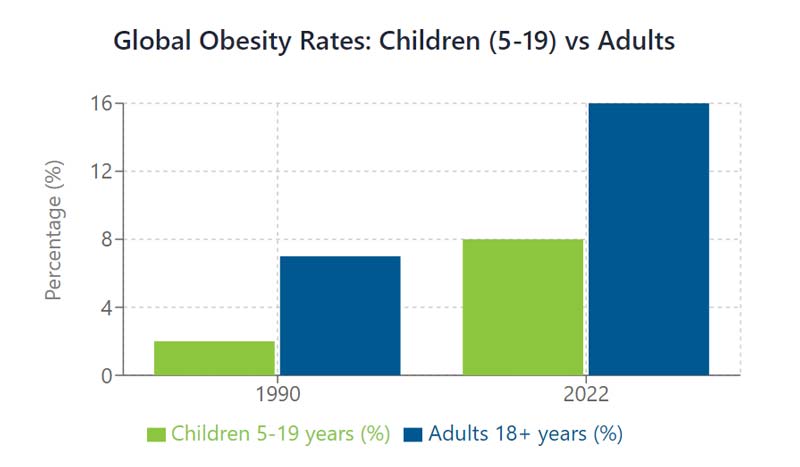By BeSund Editorial Team 11/07/2023 Modified Date: 27/11/2024
Weight Management
Explore the relationship between exercise and weight management
Weight Management and Exercise Excellence

Understanding Weight Management and Exercise
Weight management and exercise represent a critical health challenge affecting billions globally. In 2022, approximately 2.5 billion adults were overweight, with 890 million living with obesity. This reflects a significant increase from previous decades, highlighting an urgent need for effective interventions.
The complexity of weight management and exercise involves several key factors: energy intake calculations, physical activity levels, and biological responses. Research indicates that the body operates through multiple biological systems designed to defend energy stores against imbalances. These sophisticated mechanisms respond differently to weight gain versus loss, demonstrating a more robust protective response against weight reduction.
Modern lifestyles significantly influence weight management outcomes. The rise in sedentary behaviours and increased access to energy-dense foods create an environment that promotes weight gain. Additionally, individual responses to weight management interventions show considerable variation, emphasising the need for personalised approaches.
Global Prevalence and Health Impact of Weight Management
The worldwide impact of inadequate weight management and exercise continues to grow substantially. Current data reveals that 43% of adults aged 18 years and over were overweight in 2022, with 16% living with obesity. These statistics represent more than a doubling of global obesity rates since 1990.
Health implications of poor weight management extend far beyond physical appearance. Higher-than-optimal body mass index caused an estimated 5 million deaths from noncommunicable diseases in 2019. Furthermore, economic projections suggest global costs of overweight and obesity could reach US$ 3 trillion per year by 2030 and more than US$ 18 trillion by 2060 worldwide.
The rising prevalence mainly affects low- and middle-income countries, creating a complex public health challenge. These nations often face a double burden of malnutrition, simultaneously dealing with undernutrition and obesity-related health issues within the same communities.
Energy Balance and Weight Management Fundamentals
The foundation of weight management and exercise involves understanding energy balance components. Daily energy expenditure consists of three primary elements: resting metabolic rate, physical activity expenditure, and the thermic effect of food processing.
Contrary to common understanding, individuals with higher body weights typically demonstrate elevated resting energy use (the energy burned while at complete rest). This occurs because increased fat-free mass (body weight minus fat tissue) accompanies higher body weight, and it contains tissues that are constantly active and burning energy, contributing significantly to daily energy needs.
The relationship between body composition and energy use presents complex interactions. While fat-free and fat mass predicts approximately 70% of resting energy use variation, individual differences in organ sizes and their energy-burning rates create additional complexity.
Understanding Weight Management and Exercise Relationship
Physical activity is fundamental to weight management, exercise strategies, dietary intervention and behavioural support. Research demonstrates that long-term weight management typically requires 225-420 minutes of weekly physical activity.
The body demonstrates remarkable metabolic adaptations affecting exercise efficiency and energy expenditure. These adaptations influence skeletal muscle efficiency and sympathetic nervous system activity, significantly impacting overall energy balance.
Individual responses to exercise interventions show considerable variation, highlighting the importance of personalised approaches. Studies indicate that genetic factors, physiological responses, and environmental influences contribute to these differences in exercise outcomes.
Individual Factors Affecting Weight Management Success
Successful weight management and exercise outcomes depend heavily on individual characteristics and circumstances. Research indicates that maintaining substantial weight loss requires permanent adjustments between behaviours that reduce energy intake and those that increase energy expenditure.
Multiple components influence success, including self-efficacy for monitoring weight and eating behaviour, autonomous motivation, and maintaining a positive body image. Additionally, cultural and family dynamics significantly affect physical activity engagement and adherence to weight management programmes.

The Impact of Weight Management on Physical Performance
Physical capabilities and exercise performance are intricately linked to weight management and patterns. Research demonstrates that exercise capability varies significantly among individuals with different body compositions, particularly during high-intensity training sessions.
Body weight changes influence physical performance through multiple complex mechanisms involving energy use, muscle efficiency, and metabolic adaptations. When individuals lose weight, their energy expenditure decreases more than expected based on body composition changes, affecting long-term performance outcomes.
Studies indicate that successful weight management requires substantial physical activity levels. Those who maintain significant weight loss typically expend around 2,259 calories weekly through exercise, approximately 1,100 calories more than unsuccessful maintainers.
Impact of Weight Management and Exercise on Physical Capabilities
Weight management and exercise significantly influence exercise response based on body composition, with research showing that cardiovascular fitness levels differ markedly between individuals with varying weights. Initial aerobic capacity demonstrates substantial variation, with VO2 max (the maximum oxygen consumption rate during exercise) ranging from 14.9 to 39.7 ml/min/kg.
Exercise programmes require careful consideration for people with higher body weights, particularly those with a Body Mass Index (BMI, a measure of body weight relative to height) over 35. Research findings often need individual adaptation, as standard guidelines may not fully address their specific needs and limitations.
Physical activity energy costs show exciting patterns. Higher body weights sometimes result in similar daily energy expenditures as lower weights despite less physical activity. This occurs because the energy cost of movement increases with body weight.
Metabolic Adaptations in Physical Performance
Weight management and exercise lead to remarkable metabolic adaptations that affect physical capabilities. These changes influence muscle efficiency and exercise capacity, with skeletal muscles becoming more efficient at using energy after weight loss.
When body weight reduces, approximately 75% of the weight loss is due to fat loss. At the same time, the remaining portion includes lean tissue. This composition change significantly impacts overall performance capacity and energy requirements.
These metabolic adaptations persist even after weight loss, affecting energy use and exercise efficiency. Research shows these changes can continue for years, influencing long-term physical performance capabilities.
Individual and Cultural Factors in Performance
Successful weight management and exercise require understanding how physical performance capabilities reflect complex interactions between personal and environmental factors. Even among people living in similar environments, substantial differences exist in physical activity patterns and exercise engagement.
Cultural perspectives significantly influence physical activity participation. Some communities maintain different views about body size and exercise, affecting how individuals engage with physical activity programmes.
Daily life demands create unique challenges for maintaining regular exercise routines. Work commitments, family responsibilities, and time management often impact physical activity patterns and overall performance capabilities.

Exercise as a Management Tool for Weight Management and Exercise
Weight management and exercise demonstrate significant benefits when implemented systematically. Research shows consistent weight loss of 1.5 to 3.5 kg in exercise groups compared to non-exercise controls, with additional benefits when combined with dietary changes.
Evidence supporting weight management and exercise highlights its effectiveness across different populations and fitness levels.
Exercise Impact on Body Composition
Physical activity creates positive changes in how the body stores and uses fat. These adaptations include:
- Reduces visceral fat (fat stored around organs) by 21% during moderate weight loss
- Maintains muscle mass during weight reduction
- Improves overall body composition compared to diet alone
- Enhances cardiovascular fitness levels
Time of Day Effects
Morning exercise (7:00 AM to 12:00 PM) is more associated with weight loss success than afternoon sessions (3:00 PM to 7:00 PM). This timing advantage mainly benefits individuals who are establishing consistent exercise routines.
Physical Activity Requirements
Successful weight management through exercise involves several key components:
- Duration: Minimum 10-minute continuous sessions
- Intensity: Moderate to vigorous effort levels
- Frequency: 200-300 minutes weekly for optimal results
- Consistency: Regular engagement across multiple days
Exercise Types and Benefits
High-intensity interval Training (HIIT) produces similar benefits to moderate-intensity continuous training in 40% less time, making it efficient for time-constrained individuals.
Resistance Training Benefits
This form of exercise proves particularly effective for:
- Preserving lean muscle mass
- Improving strength measures
- Enhancing metabolic health
- Supporting long-term weight maintenance
Combined Exercise Approaches
Research demonstrates that mixing different exercise types provides comprehensive benefits. When aerobic and resistance training are combined:
- Cardiorespiratory fitness improves significantly
- Muscle strength increases
- Overall physical function enhances
- Weight management success rates improve
Long-Term Success Factors
Exercise proves crucial for maintaining weight loss, with successful maintainers typically expending about 2,600 calories weekly through physical activity. This level of activity:
- Supports metabolic health
- Prevents weight regain
- Enhances overall fitness
- Improves body composition
Motivation and Adherence
Successful outcomes occur most frequently when individuals:
- Choose activities they genuinely enjoy
- Feel competent in their exercise abilities
- Experience autonomy in their fitness choices
- Maintain regular contact with fitness specialists
Evidence supports structured exercise programmes lasting beyond six months, incorporating behavioural strategies and dietary modifications. This comprehensive approach helps create sustainable changes while supporting long-term weight management goals.
Regular exercise’s neurobiological impacts (changes in brain chemistry) further support its role in weight management. Physical activity increases dopamine and opioids (natural feel-good chemicals), strengthening positive associations with exercise and supporting long-term adherence.
Recommended Exercises for Individuals with Weight Management Concerns
The science behind weight management and exercise demonstrate that different exercise types yield varying effectiveness for other individuals.
Research shows that aerobic training consistently provides greater weight and fat loss effectiveness than resistance training, with an approximately 1 kg outcome difference.
Breaking exercise into smaller periods, such as three 10-minute rather than one 30-minute session, can improve adherence while maintaining cardiovascular benefits. This flexibility helps individuals incorporate physical activity into busy schedules without compromising results.
Weight Management and Exercise FITT Recommendations
Weight management and exercise programmes follow the FITT principle – Frequency (how often), Intensity (how hard), Time (duration), and Type (what kind). Understanding these components helps create compelling, personalised exercise plans:
Frequency
- Aerobic exercise: 5-7 days weekly
- Resistance training: 2-3 non-consecutive days
- Combined sessions: 3-5 days with proper rest periods
Intensity (measured by heart rate or perceived exertion)
- Moderate intensity: 50-65% of maximum heart rate
- Vigorous intensity: 70-85% of maximum heart rate
- Resistance training: 65-85% of one-repetition maximum (the heaviest weight you can lift once)
Time
- Individual sessions: 20-60 minutes
- Weekly total: 200-300 minutes
- Rest periods: 1-2 minutes between resistance exercises
Type
- Aerobic activities: walking, cycling, swimming
- Resistance exercises: weights, bands, body weight
- Flexibility work: stretching, yoga movements
Aerobic Training Design and Implementation
Successful weight management and exercise require structured aerobic training. Research indicates optimal results occur when following specific progression patterns:
Starting Level
- Begin with moderate-intensity activities
- Focus on building duration before intensity
- Use perceived exertion (ability to talk while exercising)
- Monitor heart rate if available
Progressive Development
- Increase duration by 5-10 minutes every 1-2 weeks
- Add intensity gradually through interval training
- Include both continuous and intermittent efforts
- Vary activities to maintain engagement
Resistance Training Methodology
Weight management and exercise benefits significantly from proper resistance training methods. Evidence shows resistance training helps preserve muscle mass during weight loss, which is particularly important for long-term success.
Important Training Components
- Major muscle groups targeted each session
- 8-12 repetitions per exercise
- 1-3 sets per exercise
- Progressive weight increases
- Proper form emphasis
Exercise Selection – Large Muscle Groups:
- Leg presses or squats
- Chest presses or push-ups
- Seated rows or pull-downs
- Shoulder press movements
Core Stability
- Planks and variations
- Trunk rotation exercises
- Back extension movements

Combined Exercise Approaches for Optimal Results
Weight management and exercise outcomes improve significantly when different exercise types work together systematically. Research demonstrates that mixing aerobic and resistance training yields superior results for body composition and fitness levels.
Effective Implementation
- Alternate between aerobic and resistance days
- Combine both in single sessions (aerobic first)
- Allow adequate recovery between intense efforts
- Progress gradually in all aspects
Integration Strategies
- Circuit training combining strength and cardio
- High-intensity intervals with resistance
- Supersets for time efficiency
- Active recovery between strength exercises
Safety Measures and Precautions for Weight Management and Exercise
Safe weight management and exercise begin with proper preparation. You should consult your doctor for a health check-up and discuss your exercise plans before starting any new programme.
For people carrying excess weight, thorough medical assessment becomes especially important. Healthcare professionals need to check heart health, joint conditions, and metabolism to ensure exercise recommendations suit your personal capabilities.
Your body undergoes significant changes during weight management and exercise that can last for years after reaching a lower weight. These changes affect how much energy you need and how well you can exercise, so monitoring your progress is essential.
Research shows these changes happen regardless of your starting weight, which is why personalised programme adjustments matter. Crucial safety points to remember include:
- Regular checking of heart rate and how laborious exercise feels
- Gradually increasing how long and hard you exercise
- Paying close attention to proper exercise form
- Taking enough rest between training sessions
- Regularly checking joint health and movement ability
A gradual approach to exercise works best. Start with more leisurely activities and slowly build up to more challenging ones. This method helps prevent problems while keeping your programme effective.
As you progress with exercise, it’s essential to track several factors:
- Changes in body composition
- How your heart responds to exercise
- Improvements in strength
- Better flexibility
- Any exercise-related discomfort
Cultural and religious needs play essential roles in exercise safety. Your programme should fit your personal requirements while staying practical. This might mean adapting exercises, adjusting clothing needs, and respecting individual preferences.
Working out with supervision shows better results than exercising alone. Studies show that people exercising under supervision lose about 89% of their weight after a year, compared to 53% of those exercising alone.
Age brings special considerations, particularly if you’re older. Your exercise plan should consider the following:
- Balance and stability
- Reducing stress on joints
- Heart health limitations
- The time needed for recovery
- Any movement restrictions
People who rarely exercise face higher risks when suddenly starting intense activities. That’s why you should begin to gently if you haven’t exercised regularly, slowly building up how long and hard you exercise as your fitness improves.
The length of your programme matters too. Concise Short programmes (2-4 weeks) and long ones (over 26 weeks) often show poorer results. Research suggests the best outcomes happen with programmes lasting between 4-24 weeks, giving you enough time to adapt while staying engaged.

Living with Weight Management: Fitness and Lifestyle Tips
Sustainable weight management and exercise require understanding that your body responds to weight loss, much like starvation. This triggers various changes that can promote weight regain, making it crucial to develop strategies that work with your body rather than against it.
Research shows that successful maintainers typically exercise for at least 250 minutes weekly. However, even smaller amounts of activity can support your goals when combined with other lifestyle changes. The key lies in making these changes permanent rather than viewing them as temporary fixes.
Your weight management and exercise journey becomes more accessible as new habits form and require less conscious effort. Studies show that people who lose weight for two years or more report finding it increasingly manageable, suggesting consistency helps build lasting change.
Successful maintenance involves several vital practices that become part of your daily routine. Regular self-weighing helps you stay aware of small changes before they become significant. Maintaining consistent eating patterns throughout the week, rather than alternating between strict weekday diets and weekend indulgence, proves particularly effective.
Stress management plays a vital role in long-term success. Many balance responsibilities, including work, caring for family members, and maintaining a household. Building regular exercise into your schedule, treating it like any other necessary appointment, helps maintain consistency despite life’s demands.
Cultural awareness significantly impacts one’s approach to healthy living. Traditional dietary patterns and cultural perspectives on body size influence how one interacts with food and exercise. Acknowledging these factors while making gradual modifications that respect one’s cultural background leads to more sustainable changes.
Making exercise enjoyable emerges as a crucial factor in long-term success. People who enjoy their physical activities are more likely to maintain them. This might mean trying different types of movement until you find activities that genuinely appeal to you, whether dancing, swimming, cycling, or walking with friends.
Support systems prove invaluable for maintaining healthy changes. Regular contact with healthcare professionals through various means, including telephone calls or online check-ins, can provide the encouragement and accountability needed for long-term success. Studies show that those receiving ongoing support maintain about 52% of their initial weight loss at 30 months, compared to 35% in self-directed approaches.
Sources
- Baldwin KM, Joanisse DR, Haddad F, Goldsmith RL, Gallagher D, Pavlovich KH, Shamoon EL, Leibel RL, Rosenbaum M. Effects of weight loss and leptin on skeletal muscle in human subjects. Am J Physiol Regul Integr Comp Physiol. 2011 Nov;301(5):R1259-66.
- Bellicha A, van Baak MA, Battista F, et al. Effect of exercise training on weight loss, body composition changes, and weight maintenance in adults with overweight or obesity: an overview of 12 systematic reviews and 149 studies. Obes Rev. 2021;22(Suppl 4):e13256.
- Bryan AD, Magnan RE, Hooper AE, Ciccolo JT, Marcus B, Hutchison KE. Colorado stride (COSTRIDE): testing genetic and physiological moderators of response to an intervention to increase physical activity. Int J Behav Nutr Phys Act. 2013 Dec 21;10:139.
- Camps SG, Verhoef SP, Westerterp KR. Weight loss, weight maintenance, and adaptive thermogenesis. Am J Clin Nutr. 2013;97:990–994.
- Catenacci VA, Odgen L, Phelan S, Thomas JG, Hill J, Wing RR, et al. Dietary habits and weight maintenance success in high versus low exercisers in the National Weight Control Registry. J Phys Act Health. 2014;11:1540–1548.
- Chowdhury AM, Helman C, Greenhalgh T. Food beliefs and practices among British Bangladeshis with diabetes: Implications for health education. Anthropol Med 2000;7(2):209–26.
- Chu DT, Minh Nguyet NT, Dinh TC, Thai Lien NV, Nguyen KH, Nhu Ngoc VT, Tao Y, Son LH, Le DH, Nga VB, Jurgoński A, Tran QH, Van Tu P, Pham VH. An update on physical health and economic consequences of overweight and obesity. Diabetes Metab Syndr. 2018 Nov;12(6):1095-1100.
- Craighead L, Blum MD. Supervised exercise in behavioral treatment for moderate obesity. Behav Ther. 1989;20:49-59.
- Dave SS, Craft LL, Mehta P, et al. Life stage influences on U.S. South Asian women’s physical activity. Am J Health Promot. 2015;29(3):e100–8.
- DeBusk RF, Stenestrand U, Sheehan M, Haskell WL. Training effects of long versus short bouts of exercise in healthy subjects. Am J Cardiol. 1990;65:1010-1013.
- Decker ES, Ekkekakis P. More efficient, perhaps, but at what price? Pleasure and enjoyment responses to high‐intensity interval exercise in low‐active women with obesity. Psychol Sport Exerc. 2017;28:1‐
- Ding D, Sallis JF, Conway TL, et al. Interactive effects of built environment and psychosocial attributes on physical activity: a test of ecological models. Ann Beh Med. 2012;44:365–374.
- Donnelly JE, Blair SN, Jakicic JM, et al. American College of Sports Medicine Position Stand. Appropriate physical activity intervention strategies for weight loss and prevention of weight regain for adults. Med Sci Sports Exerc. 2009;41(2):459‐
- Flack KD, Johnson L, Roemmich JN. Aerobic and resistance exercise reinforcement and discomfort tolerance predict meeting activity guidelines. Physiol Behav. 2017;170:32–36.
- Foley TE, Fleshner M. Neuroplasticity of dopamine circuits after exercise: Implications for central fatigue. Neuromolecular Med. 2008;10:67–80.
- Garber CE, Blissmer B, Deschenes MR, et al. American College of Sports Medicine position stand. Quantity and quality of exercise for developing and maintaining cardiorespiratory, musculoskeletal, and neuromotor fitness in apparently healthy adults: guidance for prescribing exercise. Med Sci Sports Exerc. 2011;43(7):1334‐
- Gell NM, Wadsworth DD. How do they do it: Working women meeting physical activity recommendations. Am J Health Behav. 2014;38:208–217.
- Gorin AA, Phelan S, Wing RR, Hill JO. Promoting long-term weight control: does dieting consistency matter? Int J Obes Relat Metab Disord. 2004;28(2):278–281.
- Grace C. Nutrition-related health management in a Bangladeshi community. Proc Nutr Soc 2011;70(1):129–34.
- Hall KD, Heymsfield SB, Kemnitz JW, et al. Energy balance and its components: implications for body weight regulation. Am J Clin Nutr. 2012;95:989–994.
- Jakicic JM, Marcus BH, Lang W, Janney C. Effect of exercise on 24-month weight loss maintenance in overweight women. Arch Intern Med. 2008;168(14):1550-9.
- Jamnik VK, Warburton DE, Makarski J, et al. Enhancing the effectiveness of clearance for physical activity participation. Appl Physiol Nutr Metab. 2011;36:S3–S13.
- Jensen MD, Ryan DH, Apovian CM, Ard JD, Comuzzie AG, Donato KA, Hu FB, Hubbard VS, Jakicic JM, Kushner RF, Loria CM, Millen BE, Nonas CA, Pi-Sunyer FX, Stevens J, Stevens VJ, Wadden TA, Wolfe BM, Yanovski SZ, Jordan HS, Kendall KA, Lux LJ, Mentor-Marcel R, Morgan LC, Trisolini MG, Wnek J, Anderson JL, Halperin JL, Albert NM, Bozkurt B, Brindis RG, Curtis LH, DeMets D, Hochman JS, Kovacs RJ, Ohman EM, Pressler SJ, Sellke FW, Shen WK, Smith SC Jr, Tomaselli GF; American College of Cardiology/American Heart Association Task Force on Practice Guidelines; Obesity Society. 2013 AHA/ACC/TOS guideline for the management of overweight and obesity in adults: a report of the American College of Cardiology/American Heart Association Task Force on Practice Guidelines and The Obesity Society. Circulation. 2014 Jun 24;129(25 Suppl 2):S102-38.
- King NA, Hopkins M, Caudwell P, Stubbs RJ, Blundell JE. Individual variability following 12 weeks of supervised exercise: identification and characterisation of compensation for exercise-induced weight loss. Int J Obes (Lond). 2008 Jan;32(1):177-84.
- Klem ML, Wing RR, Lang W, McGuire MT, Hill JO. Does weight loss maintenance become easier over time? Obes Res. 2000;8(6):438–444.
- Leibel R, Rosenbaum M, Hirsch J. Changes in energy expenditure resulting from altered body weight. N Eng J Med 1995;332:621–628.
- MacLean PS, Wing RR, Davidson T, Epstein L, Goodpaster B, Hall KD, Levin BE, Perri MG, Rolls BJ, Rosenbaum M, Rothman AJ, Ryan D. NIH working group report: Innovative research to improve maintenance of weight loss. Obesity (Silver Spring). 2015 Jan;23(1):7-15.
- McCarthy D, Berg A. Weight loss strategies and the risk of skeletal muscle mass loss. Nutrients. 2021;13(7):2473.
- Mehta NK, Patel SA, Ali MK, Narayan KV. Preventing disability: the influence of modifiable risk factors on state and national disability prevalence. Health Aff (Millwood) 2017;36:626-35.
- Nelson KM, Weinsier RL, Long CL, Schutz Y. Prediction of resting energy expenditure from fat-free mass and fat mass. Am J Clin Nutr. 1992 Nov;56(5):848-56.
- Nelson ME, Rejeski WJ, Blair SN, et al. Physical activity and public health in older adults: recommendation from the American College of Sports Medicine and the American Heart Association. Circulation. 2007;116:1094–105.
- Rosenbaum M, Hirsch J, Gallagher D, Leibel R. Long-term persistence of adaptive thermogenesis in subjects who have maintained a reduced body weight. Am J Clin Nutr 2008;88:906–912.
- Rosenbaum M, Vandenborne K, Goldsmith R, et al. Effects of experimental weight perturbation on skeletal muscle work efficiency in human subjects. Am J Physiol Endocrinol Metab 2003;285:R183–R192.
- Sarsan A, Ardiç F, Özgen M, Topuz O, Sermez Y. The effects of aerobic and resistance exercises in obese women. Clin Rehabil. 2006;20:773–782.
- Sardeli AV, Komatsu TR, Mori MA, et al. Resistance training prevents muscle loss induced by caloric restriction in obese elderly individuals: a systematic review and meta-analysis. Nutrients. 2018;10(4):423-432.
- Schoeller DA, Jefford G. Determinants of the energy costs of light activities: inferences for interpreting doubly labeled water data. Int J Obes (Lond) 2002;26:97–101.
- Schwartz MW, Woods SC, Porte D, Seeley RJ, Baskin DG. Central nervous system control of food intake. Nature. 2000;404(6778):661–671.
- Schwingshackl L, Dias S, Strasser B, Hoffmann G. Impact of different training modalities on anthropometric and metabolic characteristics in overweight/obese subjects: a systematic review and network meta‐analysis. PLoS One. 2013;8(12):1‐
- Svetkey LP, Stevens VJ, Brantley PJ, et al. Comparison of strategies for sustaining weight loss: the weight loss maintenance randomised controlled trial. JAMA. 2008;299:1139–1148.
- Taylor JL, Holland DJ, Spathis JG, et al. Guidelines for the delivery and monitoring of high intensity interval training in clinical populations. Prog Cardiovasc Dis. 2019;62(2):140‐
- Teixeira PJ, Carraça EV, Marques MM, Rutter H, Oppert JM, De Bourdeaudhuij I, Lakerveld J, Brug J. Successful behavior change in obesity interventions in adults: a systematic review of self-regulation mediators. BMC Med. 2015 Apr 16;13:84.
- Teixeira PJ, Going SB, Houtkooper LB, et al. Exercise motivation, eating, and body image variables as predictors of weight control. Med Sci Sports Exerc. 2006;38:179–188.
- Thompson PD, Franklin BA, Balady GJ, Blair SN, Corrado D, Estes NA 3rd, Fulton JE, Gordon NF, Haskell WL, Link MS, Maron BJ, Mittleman MA, Pelliccia A, Wenger NK, Willich SN, Costa F; American Heart Association Council on Nutrition, Physical Activity, and Metabolism; American Heart Association Council on Clinical Cardiology; American College of Sports Medicine. Exercise and acute cardiovascular events placing the risks into perspective: a scientific statement from the American Heart Association Council on Nutrition, Physical Activity, and Metabolism and the Council on Clinical Cardiology. Circulation. 2007 May 1;115(17):2358-68.
- Wadden TA, West DS, Delahanty L, et al. The Look AHEAD study: a description of the lifestyle intervention and the evidence supporting it. Obesity (Silver Spring) 2006;14(5):737-52.
- Westerterp KR. Diet induced thermogenesis. Nutr Metab (Lond) 2004;1:5.
- Wewege M, Van Den Berg R, Ward R, Keech A. The effects of high-intensity interval training vs. moderate-intensity continuous training on body composition in overweight and obese adults: A systematic review and meta-analysis. Obes Rev. 2017;18:635–646.
- Willis EA, Creasy SA, Honas JJ, Melanson EL, Donnelly JE. The effects of exercise session timing on weight loss and components of energy balance: Midwest Exercise Trial. Int J Obes 2020;44:114–124.
- World Health Organization. Obesity.
- World Health Organization. Obesity and Overweight – Key Facts.


